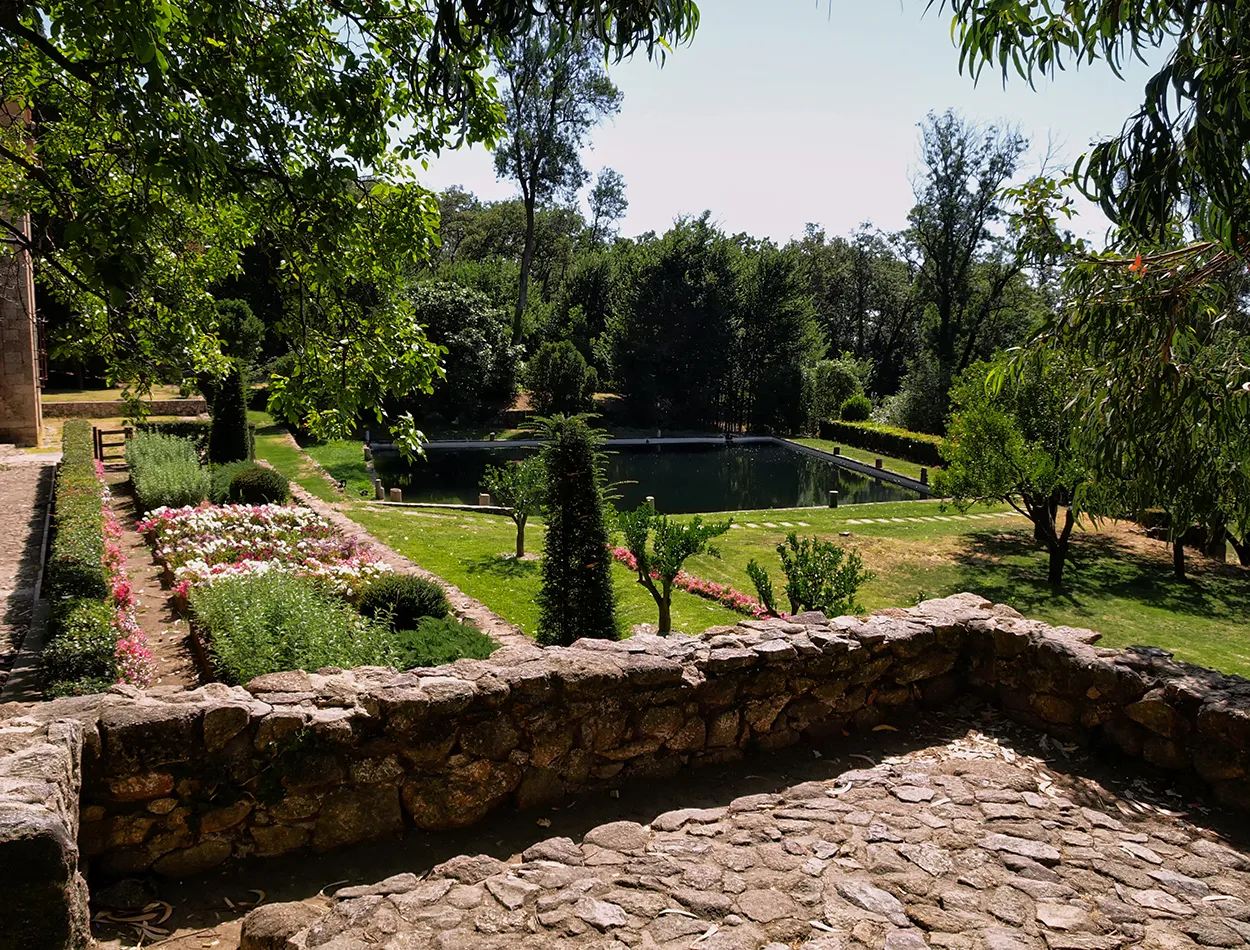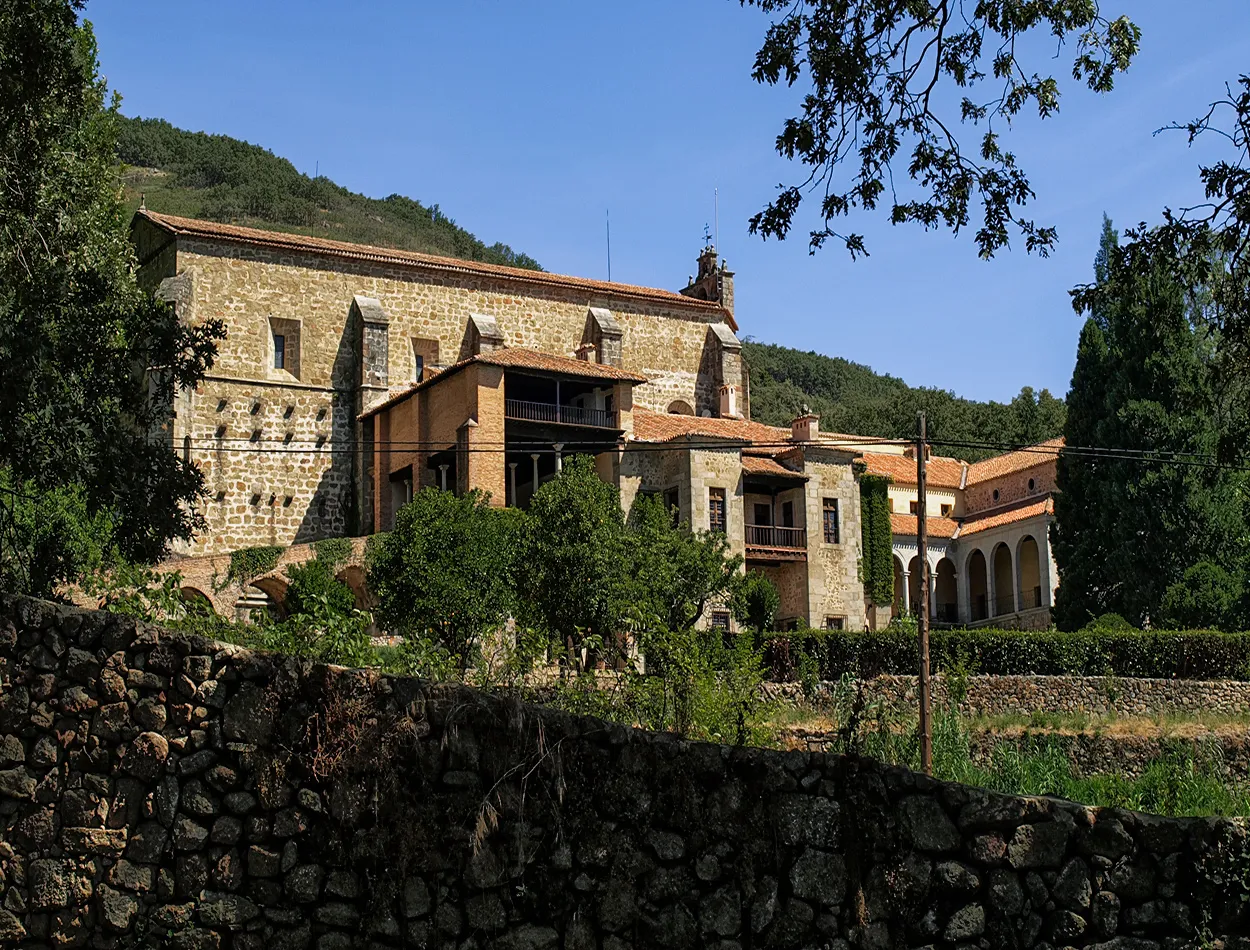

The two best-known valleys in the north of the province of Cáceres in the autonomous community of Extremadura are the Jerte Valley (known for the white blanket that covers it with the cherry blossoms in the season in March) and the Vera Valley, almost parallel to and crossed by tributaries of the Tagus River such as the Arroyo de Yuste, which are the destination of my trip to this historic monastery of the Jerónimos de Yuste located there. This is an area of rivers and small streams that form pools and gorges of a very well-preserved natural and scenic beauty, a natural space that accompanied me on this expedition through the area. I began this expedition leaving the city of Cáceres on the N-110 highway to take the regional EX-203 that would take me to Cuacos de Yuste, to the monastery and the German cemetery located very close to the convent. I also took the opportunity to visit a small nearby town called Garganta de la Olla, where the river forms different waterfalls and pools, preserving a rural beauty that blends in with the natural surroundings of the area.
Los dos valles más conocidos del norte de la provincia de Cáceres en la comunidad autónoma de Extremadura son, el valle del Jerte (conocido por el manto blanco que lo cubre con la floración del cerezo en la temporada en el mes de marzo) y el valle de la Vera casi en paralelo y atravesado por afluentes del río Tajo como el Arroyo de Yuste son el destino de mi viaje a este histórico monasterio de los Jerónimos de Yuste ubicado en él. Esta es una zona de ríos y pequeños arroyos que forman pozas y gargantas de una belleza natural y paisajista muy bien conservada, un espacio natural que me acompaño en esta expedición por la zona. Esta expedición la comencé saliendo de la ciudad de Cáceres por la carretera N-110 para tomar la regional EX-203 que me llevaría a Cuacos de Yuste, al monasterio y al cementerio alemán ubicado muy cercano al convento. También aproveche para ir a un pequeño pueblo cercano llamado Garganta de la Olla donde el río va formando diferentes saltos y pozas conservando una belleza rural que mimetiza con el entorno natural de la zona.








The Jerónimos Monastery of Yuste is an important part of the history of Spain, since it was here that Emperor Charles I of Spain and V of the Holy Roman Empire retired, giving it the character of a spiritual retreat to one of the greatest representatives of power in those years. Charles V died after spending the last two years of his life there and then his remains were transferred to the Escorial Monastery in Madrid. The monastery was declared a European heritage site and a site of cultural interest in 2007, and I must say that when you visit it you understand this distinction, since its conservation, location and architecture deserve it. I am always surprised when I travel and visit these places by the feeling it gives me of being at a certain point in history that seems to come back and come alive when you walk through these places.
El Monasterio de los Jerónimos de Yuste es una parte importante de la historia de España ya que en él fue donde se retiro el emperador Carlos I de España y V del Sacro imperio romano germánico dándole un carácter de retiro espiritual a uno de los mayores representantes del poder en aquellos años. Carlos V murió después de pasar los dos últimos años de su vida y luego sus restos fueron trasladados al monasterio del Escorial, en Madrid. El monasterio fue declarado patrimonio europeo y bien de interés cultural en el año 2007 y he de decir que al visitarlo se comprende esta distinción ya que su conservación, ubicación y arquitectura se lo merecen. Siempre me sorprende cuando viajo y visito estos lugares la sensación que me produce de estar en un punto determinado de la historia que parece que se vuelve y se revive cuando uno pasea por estos lugares.


















German Cementery of Yuste / Cementerio Alemán de Yuste


Continuing on my route and very close to the monastery of Yuste, I found a cemetery with granite crosses in a line between a field of olive groves. I was very surprised by this place, as it was a cemetery for German soldiers from the First and Second World Wars, airmen and sailors who had their resting place there. I found out about the history of those burials in this place and found out from the people who looked after that place that most of the soldiers were airmen from the so-called “Luftwaffe” or German air force and also sailors from various submarines that caused terror in the waters of the Atlantic during the Second World War. There were several signs and one of them read the following ;
“In this soldiers’ cemetery rest 26 soldiers from the First World War and 154 from the Second World War. They belonged to the crews of planes that fell on Spain, submarines and other sunken navy ships. Some of them died in Spanish hospitals from their wounds. Their graves were scattered all over Spain, wherever the sea washed them ashore, wherever their planes crashed, or wherever they died. The Volksbund in the years 1980-1983 brought them together in this final resting place, which was inaugurated in the presence of the ambassador of the Federal Republic of Germany at a Spanish-German commemorative event on June 1, 1983. Remember the dead with profound respect and humility.”
I am copying the text of this poster to attach this information that completes this visit to this unforgettable place.
Siguiendo con mi ruta y muy cercano al monasterio de Yuste encontré un cementerio con cruces de granito en línea entre un campo de olivares. Me sorprendió mucho aquel lugar ya que se trataba de un cementerio de soldados alemanes de la primera y segunda guerra mundial, aviadores y marinos que tenían su lugar de descanso en él. Me informe sobre esta historia de aquellos enterramientos en este lugar y averigüe por medio de las personas que cuidaban aquel lugar que la mayoría de los soldados eran aviadores de la llamada “Luftwaffe” o fuerza aérea alemana y también marineros de varios submarinos que causaron el terror en las aguas del Atlántico durante la segunda guerra mundial. Había varios carteles y en uno de ellos ponía lo siguiente ;
“En este cementerio de soldados descansan 26 soldados de la Primera Guerra Mundial y 154 de la Segunda Guerra Mundial. Pertenecieron a tripulaciones de aviones que cayeron sobre España, submarinos y otros navíos de la armada hundidos. Algunos de ellos murieron en hospitales españoles a causa de sus heridas. Sus tumbas estaban repartidas por toda España, allí donde el mar los arrojó a tierra, donde cayeron sus aviones o donde murieron. El Volksbund en los años 1980–1983 los reunió en esta última morada inaugurada en presencia del embajador de la República Federal de Alemania en un acto conmemorativo hispano-alemán el 1 de junio de 1983. Recordad a los muertos con profundo respeto y humildad.”.
Copio el texto de este cartel para adjuntar esta información que completa esta visita a este inolvidable lugar.








Gorge of the Olla / Garganta de la Olla

A few kilometres from Yuste, in the nearby mountains, I headed towards the small town of Garganta de la Olla. A winding road between small mountains took me to a viewpoint where I had the opportunity to see the town and its surrounding landscape in perspective. The small town was at the foot of the Tormantos mountain range and its main feature is a set of pools and gorges where the riverbed gives shape to the place. It has a rich natural heritage of gorges and the largest, Majadillos and Piornala, stand out. The town is charming, the people, customs and gastronomy are excellent. Walking through the Gorge of La Olla is to feel the rural world of this area in an authentic and unique way.
A pocos kilómetros de Yuste en la sierras cercana me dirigí hacia la pequeña población de Garganta de la Olla. Una carretera sinuosa entre pequeñas montañas me llevo a un mirador donde tuve la oportunidad de ver en perspectiva el pueblo y su paisaje aledaño. El pequeño pueblo se presentaba a los pies de la sierra de Tormantos y que tiene como característica principal un conjunto de pozas y gargantas donde el cauce del riachuelo da forma al lugar. Posee un rico patrimonio natural de gargantas y destacan la mayor, la de Majadillos y la Piornala. El pueblo es encantador, las gentes, costumbres y gastronomía son excelentes. Caminas por la garganta de la Olla es sentir el mundo rural de esta zona de una forma autentica y única.







|

|

|

The legend of the Serrana / la leyenda de la Serrana
The legend of the Serrana de la Vera is very present in this town as a myth. It was written and collected by Luis Pérez de Guevara and López de Vega and is the most popular and renowned legend of Extremadura. Local elves, ladies, nymphs and others are mixed in this mythological story that fits in with the very special landscape of this region.
La leyenda de la Serrana de la Vera está muy presente en este pueblo como mito, fue escrita y recogida por Luis Pérez de Guevara y López de Vega y se trata de la leyenda extremeña más popular y con más renombre. Duendes de la zona, damas, ninfas y otros se mezclan en esta historia mitológica que se acopla al paisaje tan especial de esta región.











The Jerónimos Monastery of Yuste, the German cemetery and the town of Garganta de la Olla share a privileged place in the Vera Valley and are very close centres to visit in a short space of time. I share my trip and leave a record of my experience on the world map. I extend an invitation to visit the beautiful places that I present to you. Greetings friends.
El Monasterio de los Jerónimos de Yuste, el cementerio alemán y la población de garganta de la Olla comparten un lugar privilegiado en el Valle de la Vera y son núcleos muy cercanos para visitar en breve espacio de tiempo. Comparto mi viaje y dejo constancia de mi experiencia en el mapa mundial. Les extiendo una invitación para visitar los bonitos lugares que les presento. Saludos amigos.





| Categoría | Phototalent |
| Ajustes | ISO-100 f/8 1/100s |
| Cámara | Nikon D7100 - Olympus E410 y Kodak Z |
| Lente | Nikkor or Olympus |
| Localización | Spain |


Image ©oscarps. All Rights Reserved.
Original content by @oscarps

